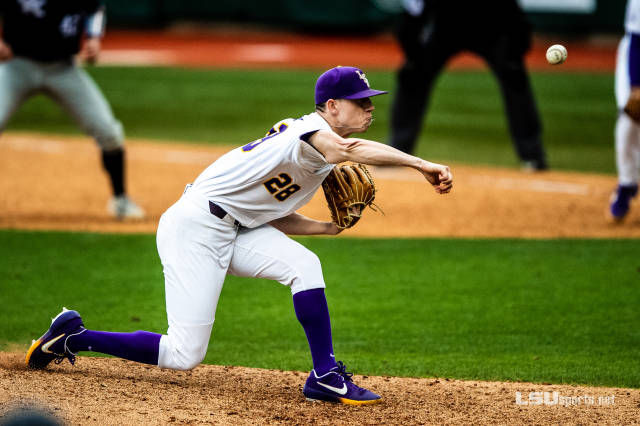
By JAMES MORAN | Tiger Rag Associate
The clock never struck midnight on Cinderella last June, with underdog Coastal Carolina punctuating a magical run with its first ever College World Series crown.
This year, however, June in Omaha belongs to the Blue Bloods.
There’s 12 combined national championships between LSU, Cal State Fullerton and Oregon State alone, and the fourth team on that side of the bracket, Florida State, has the most appearances by a program to have never won it all (22).
Shift over to the other pod and there’s three national seeds — No. 3 Florida, No. 6 TCU and No. 7 Louisville — along with Texas A&M. TCU is making its fourth straight College World Series while Florida is making its third in a row.
All of that adds up to a whole lot of star power and name recognition bound for Omaha, and it should produce some exquisite baseball.
To better get a sense of the field, here’s a Tale of the Tape sizing up the Omaha Eight and some of the very best players and pitchers who’ll lace them up at TD Ameritrade Park this weekend.
TALE OF THE TAPE
Regular readers may recall the data story we posted before the NCAA Tournament began regarding the average national ranks of teams that’ve made it to Omaha in the BBCOR bat era (since 2011) in nine different metrics.
| Metric | Omaha Average | LSU | Florida State | Oregon State | Cal State Fullerton | Louisville | Florida | Texas A&M | TCU |
| ERA | 23 | 21 | 36 | 1 | 23 | 3 | 22 | 15 | 63 |
| Hits/9IP | 25 | 11 | 35 | 1 | 54 | 4 | 67 | 23 | 25 |
| K/9IP | 60 | 29 | 13 | 68 | 145 | 11 | 31 | 33 | 10 |
| BB/9IP | 70 | 106 | 31 | 6 | 4 | 41 | 32 | 48 | 36 |
| Field % | 40 | 10 | 114 | 35 | 8 | 48 | 14 | 49 | 78 |
| BA | 85 | 45 | 152 | 39 | 160 | 67 | 205 | 130 | 147 |
| Runs | 46 | 13 | 5 | 88 | 112 | 18 | 79 | 51 | 24 |
| HR | 89 | 43 | 22 | 209 | 114 | 28 | 86 | 75 | 59 |
| Walks | 35 | 40 | 1 | 30 | 80 | 31 | 16 | 78 | 6 |
Statistically speaking, these numbers continue to back up the trend indicated by the “Omaha Average” of College World Series participants since 2011: pitching is critical.
Of the eight team that’s made it to this hallowed ground, seven rank in the top 36 nationally in ERA. Six of the eight rank in the top 35 in hits allowed per nine innings. Compare that to only half of the field ranking in the top 50 in runs scored and two of the eight ranking top 50 in team batting average.
Looking at teams as a whole, Louisville ranks within the “Omaha Average” in every category but one (fielding percentage). LSU ranks within the average in every category but two (BB/9 allowed and walks).
THE DUDES
- 1B/LHP Brendan McKay (Louisville): It’s not hard to figure out why the likely National Player of the Year went fourth overall in the MLB Draft on Monday night. He’s both the big bat in the heart of the Cardinal order (.343, 17 HR, 56 RBI) and their ace on the mound (10-3, 2.34 ERA, 140 K).
- RHP Alex Faedo (Florida): LSU is well aware how tough to deal with the Gator ace is when he’s on his game. On a staff loaded with premium arms, Faedo, a first-round pick in Monday’s draft, leads the way at 7-2 with a 2.55 ERA and 135 strikeouts in 109.1 innings of work.
- RF Greg Deichmann (LSU): The lefty-swinging slugger is the straw that stirs the drink for LSU, to borrow a line from the great Reggie Jackson. He leads the Tigers with 19 home runs, 72 RBI and a .606 slugging percentage and has a game-changing arm in right field.
- LHP Luke Heimlich (Oregon State): Well-chronicled controversy surrounds the Beaver ace, but if he returns to pitch, he’s the best arm in Omaha. The southpaw went 11-1 this season with a 0.76 ERA and struck out 128 batters in 118.1 innings of work.
- 3B Dylan Busby (Florida State): It’s not every day you see a college third baseman who hits like the Seminole slugger. Busby led Florida State with 14 home runs and 140 total bases while ranking second on the team in batting average (.315) and RBI (62).
- C Evan Skoug (TCU): A veteran presence behind the plate for the ever-consistent Frogs, the jounior experienced a power surge in 2017. His 20 home runs are the most of anyone left in the tournament, and with Luken Baker injured, TCU needs him to keep raking.
- 2B Braden Shewmake (Texas A&M): Let’s get one thing straight: This Aggie No. 3 hitter doesn’t hit like a true freshman middle infielder. Shewmake leads Texas A&M in batting average (.335), doubles (17), home runs (11), RBI (68) and total bases (143).
- RHP Brett Conoine (Cal State Fullerton): As the only team in the field not in the top 100 nationally in runs scored, Cal State Fullerton has gotten to this point by being excellent in close games. With 15 saves and a 1.49 ERA, their sophomore closer is a big reason why.




Be the first to comment